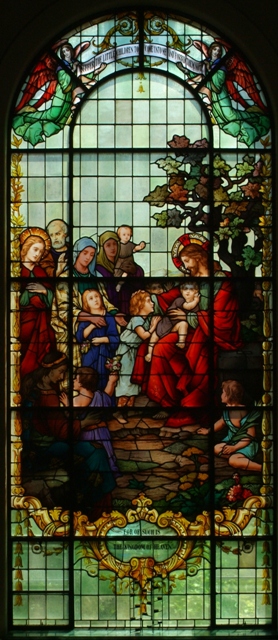
Jesus blesses the little children
Jesus blessing the children is one of the most endearing images in Christian art. The window at St. John’s depicts a conventional design. Jesus, seated on a garden bench, holds a lively, curly-haired toddler in his lap, as he stretches out his hand to a youth who eagerly approaches him. Around them, mothers and children patiently wait for a blessing; one small boy (bottom left) proffers a bouquet of flowers, while another (bottom left) grasps a palm branch. An older man stands behind the woman with the blue veil and is perhaps her husband and father of the boy she holds. These three figures are reminiscent of the holy family: an older man, a young mother and a son. At the far left St. John the Evangelist stands in for the disciples who accompanied Jesus during this event and rebuked the crowd for wasting the Lord’s time upon little children. Lack of space and/ or a desire to single out the Chapel’s patron saint might explain the omission of other apostles. Jesus receives the families in a garden beneath a tree whose leaves of varying hues subtly herald the turning of the season. At the top of the window is the quote, “Suffer the little children to come unto me and forbid them not.” At the bottom is “For such is the kingdom of heaven.” (Matt. 19:13-15)
To understand this scene fully, we must consider an earlier event when the disciples approach Jesus and ask, “Who thinkest thou is the greater in the kingdom of heaven.” (Matt. 18: 1-5) In response, Jesus called unto him a little child and set him in their midst and said, “Unless you be converted and become as little child, you shall not enter into the kingdom of heaven. Whoever therefore shall humble himself as a little child, he is the greater in the kingdom of heaven.” Christ’s words to the places where he had performed great works to no avail elucidate his teaching, “I thank thee, Father, Lord of heaven and earth, that thou has hidden things from the wise and understanding and revealed them to babes.” (Matt. 11:25)
When we consider the image of Jesus blessing the children with the earlier Gospel passages in mind, several messages emerge. The first is the necessity for Christians to become like children in order to enter the kingdom of heaven. How does this work? By becoming child-like in humility and trustfulness we recognize our dependence on God our Father and abandon ourselves to his providence and will for our lives. Only through submission to the Father’s will can we fulfill our calling and obtain hope for salvation. That we are all children of God, who is our Father, is another theme of the window. The allusion to the holy family implied in the figures of the older man, young woman and boy underscores this idea. How marvelous to think that we are members of God’s intimate family! The intimacy of the members of the Body of Christ—that is, the Church—is expressed most profoundly in the celebration of the Mass, which takes place in the nave below. Thus the image is most appropriate for its location. The gathering of the elderly man, young woman, and children around Christ in the window also reminds us that the Liturgy takes the form of a dialogue and as such signifies the people’s response in faith to Christ. In the celebration of the mass we have the courage to address God as Jesus taught us—as Father or “Abba,” meaning Papa.